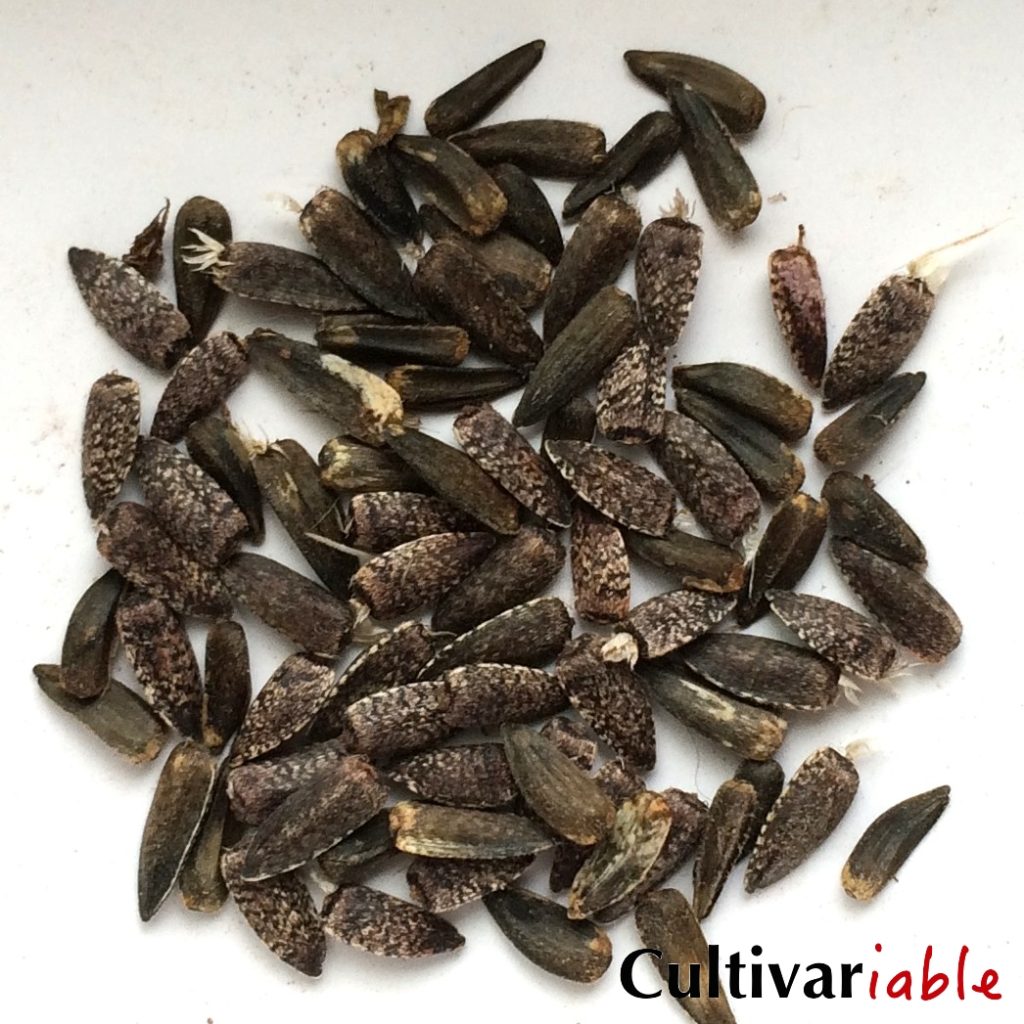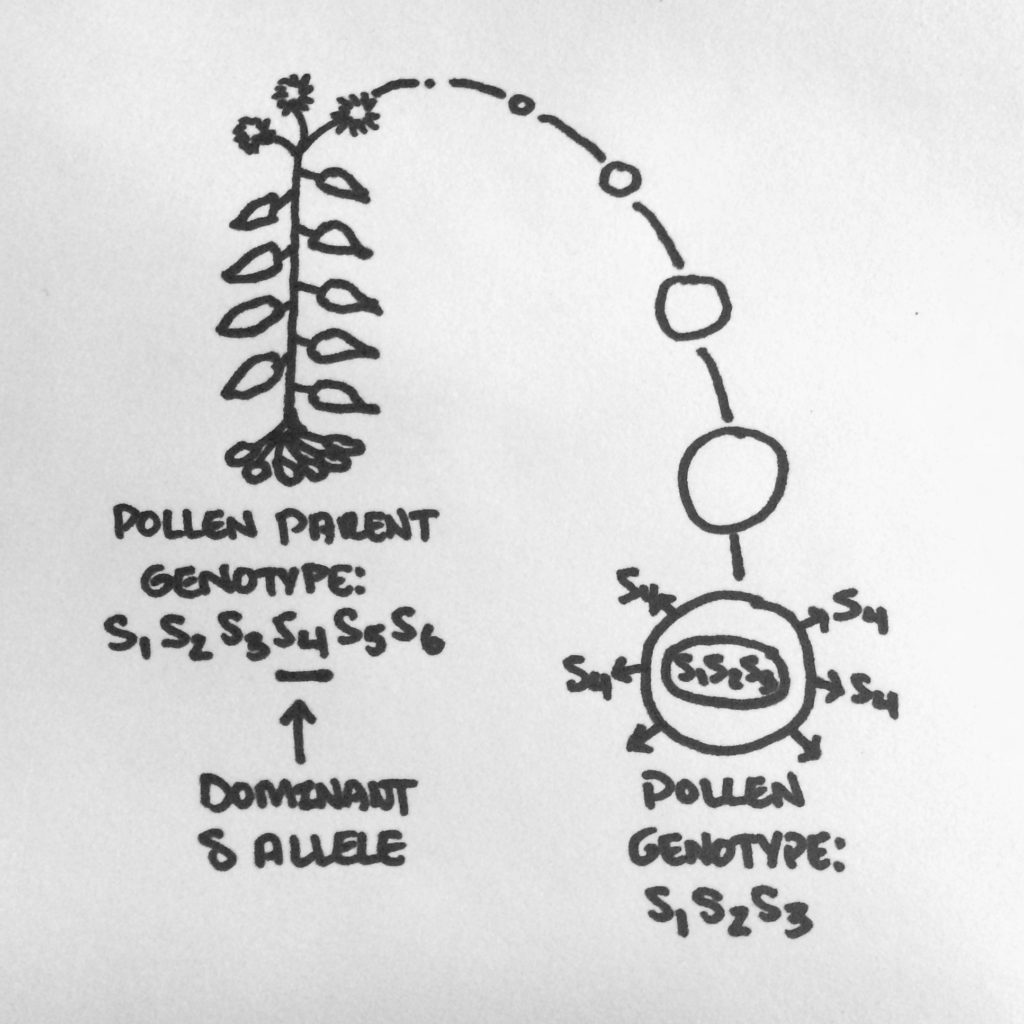No products in the cart.
Blog, breeding, Jerusalem artichoke (Helianthus tuberosus)
Jerusalem Artichoke: True Seed Production
Some of the more frequent questions that people ask me center on obtaining seed from Jerusalem artichokes for breeding. Many crops that are propagated from tubers have a reduced capability for sexual reproduction. You will see this theme come up again and again in this blog, but the details differ from one species to another.

The limitations to Jerusalem artichoke seed production fall primarily into two areas:
- Late or no flowering
- Self-incompatibility
Flowering
One of the most common complaints among people who wish to breed Jerusalem artichoke is that the plants don’t flower. Some varieties are simply poor flowerers and cannot be induced to flower even under normally favorable circumstances. Such varieties are actually fairly uncommon, so we don’t need to spend a lot of time trying to figure out how to force them. Better to skip over those and focus on the larger number of varieties that can be more readily convinced to flower with a few tricks.
Jerusalem artichoke is photoperiodic for both flowering and tuber production. There are a few day neutral varieties that will flower even during the long days of summer (Stampede is the common one) but the vast majority are short day plants. To flower, the plant must be mature enough to have entered its photoreceptive period, the day length must be less than the critical period of 13.5 to 13 hours, and the conditions must persist for at least 16 days.
This can appear confusing at first if you watch when people in different regions report flowering. It is not unusual to see varieties that have a characteristic short day response in some climates flower early in others. The reason is interaction between plant maturity and day length. Under favorable conditions, plants can be mature enough to enter the photoreceptive stage after as little as 50 days. Most clones require a longer maturation period, but a few are this early. Add 16 days for the photoperiod response to kick in and you can figure that the earliest varieties can flower at about 66 days after emergence.
In most of the plant’s native range, the soil will not be warm enough for the tubers to sprout until April at the earliest, which would have the plants entering the photoreceptive period in June. By that time, at higher latitudes, day length exceeds 13.5 hours, so the plants will not have an opportunity to flower until after the day length drops back below 13.5 hours in early September.
In milder and more southern climates, the plants can be started earlier. For example, plants grown in the southern US may sprout in late February or early March. They would enter the photoreceptive stage in late April or early May, when the day length is still less than 13.5 hours. Flowering could begin before the end of May. This is still a short day response, it is just triggering in response to spring day length rather than fall.
Early flowering can be achieved in mild climates where the soil is not warm enough to prompt sprouting by starting the plants indoors and planting them out as early as possible. It’s not a sure bet, because the growth rate of the plants is slow in chilly spring temperatures, but if you are lucky with the weather, you can get spring flowering in most mild climates. Alternatively, you can grow plants to maturity in a high tunnel, which will give more predictable flowering in most cases as the plants mature more quickly in the warmer environment.
If you don’t want to go to all of that trouble, most varieties will flower in the fall if they are mature. Most begin flowering in mid to late September. It takes 40 to 60 days to go from flower to mature seed, depending on temperature and humidity. If your climate is mild enough that the plants can survive into late October or November, then you should not have any trouble collecting seed. If you are at risk of hard freezes by that point, spent flowers can be cut from the plant and grown in water indoors to mature the seed.
Self-incompatibility
After no flowering, the next most common complaint with Jerusalem artichokes is that the plants flower abundantly but don’t set any seed. The reason for this is usually pretty straightforward: Jerusalem artichoke is an outbreeding species. Varieties are self-incompatible. As a consequence, you must have more than one variety to produce seeds. In addition, those varieties must be compatible and must flower at the same time. Jerusalem artichoke incompatibility is more than just self-incompatibility and varieties that are closely related can also be expected to be strongly incompatible. The simplest way to ensure seed production is to grow a lot of varieties and to allow them to open pollinate. That will probably satisfy most people. Read on for the more complicated version.
Plants employ two primary kinds of self incompatibility, structural and genetic. Structural incompatibility involves things like imperfect flowers with different sexes on different plants or male flowers that open after female flowers to prevent self-pollination. Jerusalem artichoke has genetic self incompatibility. In genetic incompatibility, the ability of pollen to germinate is controlled by the interaction of S locus alleles in each parent. There are two kinds of genetic incompatibility: gametophytic self incompatibility (GSI) and sporophytic self incompatibility (SSI). GSI is the less strict of the two; pollen will germinate if it has at least one S allele in its haploid genome that is not present in the pistil. SSI is more complicated; pollen will germinate only if the pollen coat phenotype expressed by the S alleles of the parent does not match any of the S alleles of the pistil.

If you had a hard time understanding that, join the club. It took me several revisions of this post to realize that I didn’t know what I was talking about. Hopefully I do now. GSI and SSI appear very similar, but SSI is actually much more complicated. In SSI, the S locus controls the creation of elements in the pollen coat that interact with the receiving stigma to determine compatibility. The S alleles can be dominant, co-dominant, or recessive, which allows for significant variations in compatibility. For example, if one of the alleles is dominant, it is the only one that matters in determining compatibility.
Jerusalem artichoke has sporophytic self incompatibility. Varieties are, at least in theory, completely self-incompatible because no matter which dominant alleles might be expressed in the pollen coat, they will still be present in the pistil. In practice, one study found 0.29% successful self-pollinations. That’s certainly not encouraging, but if you have lots of plants and lots of time, you might be able to inbreed.
Jerusalem artichoke is a polyploid species and polyploidy has significant ramifications for genetic self-incompatibility systems. Gametic self-incompatibility tends to break down with polyploidy, since increasing the number of S alleles makes compatibility more likely. Potatoes are a good example of this, where diploids have a functioning GSI system, but polyploids do not. Sporophytic self-incompatibility, at least in theory, goes in the opposite direction; the addition of more S alleles makes incompatibility more likely. In reality, the interaction of SSI and polyploidy has unpredictable results. Because of that, this post becomes speculative from this point forward. I have found no research that describes how the SSI system of Helianthus functions in polyploids, so I am assuming that it works exactly as it does it diploids, only with more S alleles in each gamete. Jerusalem artichoke is hexaploid, so plants have six S alleles.
Let’s do an example of a cross between two varieties with a large amount of overlap in S alleles. Say that we want to cross a variety that has the S genotype S1S2S1S3S1S4 with a variety that has the S genotype S1S4S1S5S1S6. The outcomes depend on how many of the S alleles present in the pollen parent are dominant. Crosses are only compatible if the dominant S allele is not present in the female parent. In the following chart, I have marked some of the S alleles in green to indicate that they are dominant or co-dominant. (Although these look like genotypes, they are being used as phenotypes, because they show you the genes that are expressed, rather than those that are present in the DNA contained within the pollen.) As you can see, compatibility is only possible if the pollen parent has dominant S alleles that do not exist in the pollen receiving plant.
| Pollen Phenotypes |
||||||
| S1S2S1S3S1S4 | S1S2S1S3S1S4 | S1S2S1S3S1S4 | S1S2S1S3S1S4 | S1S2S1S3S1S4 | S1S2S1S3S1S4 | |
| S1S4S1S5S1S6 | – | + | + | – | – | + |
Happily, it is not important to understand these details when saving open pollinated seed. Once you begin breeding subsequent generations, you are likely to run into increasing problems with backcrosses and sibling crosses. It will probably be necessary to periodically introduce new crosses with varieties that have different S alleles.
It would be perfectly sensible at this point to ask how you can determine which S alleles a given variety possesses. Unfortunately, short of genotyping varieties in a laboratory, the only thing that you can do is try to cross varieties and see if it works.
Collecting and Preserving Seed
The majority of varieties flower for a fairly long period of time, between 70 and 100 days. Of course, in shorter season climates, flowering is often truncated by freezing weather. Flowering begins at the apex, then opening on laterals moving down the stem. You will need to collect seed heads regularly as they mature at different times. Fully mature seed heads are often damaged by birds, so it is usually best to harvest them a little early and allow them to finish and dry down inside. You can also cover them with netting.
If you are in a climate with a wet fall, you may need to take steps to prevent seed from molding. I dry batches of 200 seeds with 10 grams of silica desiccant for two weeks, which results in good quality, storeable seed even in our very humid climate. Seeds appear to have very long life under even room temperature storage, germinating with very little difference between 1 and 5 years.

https://www.nature.com/articles/6800526
Arabidopsis lyrata is a diploid sporophytic self-incompatibility plant.
It has some tetraploid sub-populations.
The japan tetraploid is self-compat SC.
the Austria tetraploid is self-incompat SI.
the polypoid in this case did opposite effect on 2 different populations.
Thanks Su-yi! That is very interesting. The interactions between polyploidy and SSI are complicated. I don’t understand them as well as I would like to, so it is helpful to have more examples.
How do i get just the jerusalem artichoke seeds?? SEEDS ONLY!!
They are hard to produce, so I don’t have them every year. Maybe next year.
Hey bud. I have some extras. Drop me an instagram handle and we can talk details. I wouldn’t charge. I’m happy to share.